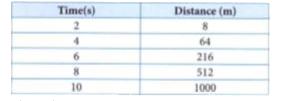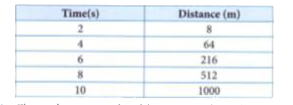A moving bicycle comes to rest after sometime if we stop pedalling it. But Newton's first law of motion that a moving body should continue to move for ever, unless some external force acts on it. How do you explain the bicycle case?
If we stop paddling a bicycle which is moving at uniform speed, the bicycle does not go on moving forever, it comes to rest after some time. The moving bicycle has been compelled to change its state of uniform motion by the external force of air resistance and fiction . If there were no air resistance and no friction to oppose the motion of the bicycle , then according to first law of motion. a moving bicycle would go on moving for ever . It would not stop by itself . Therefore , Newton's law is applicable here.
Topper's Solved these Questions
- BOOK - AAKASH INSTITUTECHAPTER - LAWS OF MOTIONEXERCISE - Illustration5videos
LAWS OF MOTION
- BOOK - AAKASH INSTITUTECHAPTER - LAWS OF MOTIONEXERCISE - TRY YOURSELF67videos
LAWS OF MOTION
- BOOK - AAKASH INSTITUTECHAPTER - KINETIC THEORYEXERCISE - EXERCISE (ASSIGNMENT) SECTION - D Assertion - Reason Type Questions10videos
KINETIC THEORY
- BOOK - AAKASH INSTITUTECHAPTER - MAGNETISM AND MATTER EXERCISE - ASSIGNMENT (SECTION D)26videos
MAGNETISM AND MATTER
Similar Questions
A moving bicycle comes to rest after sometime if we stop pedalling it. But Newton's first law of motion that a moving body should continue to move for ever, unless some external force acts on it. How do you explain the bicycle case?
View SolutionA part of Newton's first law states that a body continuous to move uniformly in the absence of an external force appears contradictory Comment.
View Solution
Knowledge Check
- Question 1 - Select One
When a body is moving uniformly along a straight line and there is no force of friction, acceleration/retardation of the body. According to Newton's second law of motion, the magnitude of force acting on a body is the product of mass and acceleration of the body
The distance - time table of an object in motion is given below

The force acting on the objectAincreasesBdecreasesCremains unchangedDnone of these - Question 2 - Select One
When a body is moving uniformly along a straight line and there is no force of friction, acceleration/retardation of the body. According to Newton's second law of motion, the magnitude of force acting on a body is the product of mass and acceleration of the body
The distance - time table of an object in motion is given below

Which among the Newton's laws of motion can be used to calculate the force acting on the object in motion ?AFirst lawBSecond lawCThird lawDnone of these - Question 3 - Select One
When a body is moving uniformly along a straight line and there is no force of friction, acceleration/retardation of the body. According to Newton's second law of motion, the magnitude of force acting on a body is the product of mass and acceleration of the body
The distance - time table of an object in motion is given below

In the given table, acceleration of the object isAincreasingBdecreasingCconstantDnone of these
A body continues to move along the same straight line some external force compels it to change its direction of motion Rather the body moving along a straight line opposes the force that tries to change its straight line the path This is well known property of inertia of direction Read the above passage and answer the following questions:
(i) Mud guards over the wheels of an auto save us from mud .How ?
(ii) What are the implication of this study in day to day life?View SolutionOne end of a light string is slipped around a peg fixed in a horizontal table top, while the other end is tied to a 0.5 kg small disc. The disc is given an initial velocity of magnitude 3.4m/s so that it moves in a horizontal circle of radius 0.75 m. The object comes to rest after 2.5 revolutions (a) For the entire motion, what work is done by the frictional force ? (b) Assume that the magnitude of the frictional force is constant and determine the coefficient of kinetic friction at the interface (c) Determine the tension in the string at the instant that the disc completes the first revolution (d) How much work is done by the tension in the string ?
View SolutionA car is traveling at 7.0 m/s when the driver applies the brakes. The car moves 1.5 m before it comes to a complete stop. It the car had been moving at 14 m/s, how far would it have continued to move after the brakes were applied ? Assume the braking force is constant .
View SolutionWhen a body is moving uniformly along a straight line and there is no force of friction, acceleration/retardation of the body. According to Newton's second law of motion, the magnitude of force acting on a body is the product of mass and acceleration of the body
The distance - time table of an object in motion is given below

A passenger in a moving train tosses a coin which falls behind him. This shows that the motion of train isView SolutionWhen a body is moving uniformly along a straight line and there is no force of friction, acceleration/retardation of the body. According to Newton's second law of motion, the magnitude of force acting on a body is the product of mass and acceleration of the body
The distance - time table of an object in motion is given below

Choose the correct order of the corresponding velocities of the object (in ms−1 ) in different time intervals .View Solution

